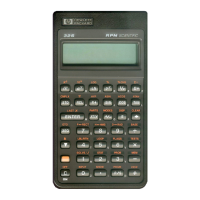Order
of
Calculation
In chapter 1 we recommended solving chain calculations by
working
from the innermost parentheses outward. However, you can also
choose to work problems in a left-to-right order.
For example, in chapter 1 you calculated:
4 -^ [14 + (7 x 3) - 2]
by starting with the innermost parentheses (7 x 3) and working out
ward—just as you would with pencil and paper. The keystrokeswere:
7 I
ENTER
I3
014
0 2 0 4
£*2
0.
Working
the problem left-to-right, the solution would be:
4 |
ENTER
|14|
ENTER
I7 I
ENTER
I3
00
2
00,
which takes one additional keystroke. Notice that the first intermedi
ate result is still the innermost parentheses: (7 x 3). The advantage to
working a problem left-to-right is that you don't have to use
|x$yl
to
reposition operands for noncommutative functions
(0
and
0).
The first method (starting with the innermost parentheses) is often
preferred because:
• It takes fewer keystrokes.
• It requires fewer registers in the stack.
When using a left-to-right method, be sure that no more than four
intermediate
numbers
(or results) will be
needed
at
one
time, since
the
stack can hold no more
than
four numbers at once. This example,
when solved left-to-right, needed all the registers in the stack at one
point.
4 -r [14 + (7 x 3) - 2]
2:
The
Automatic
Memory
Stack
45

